
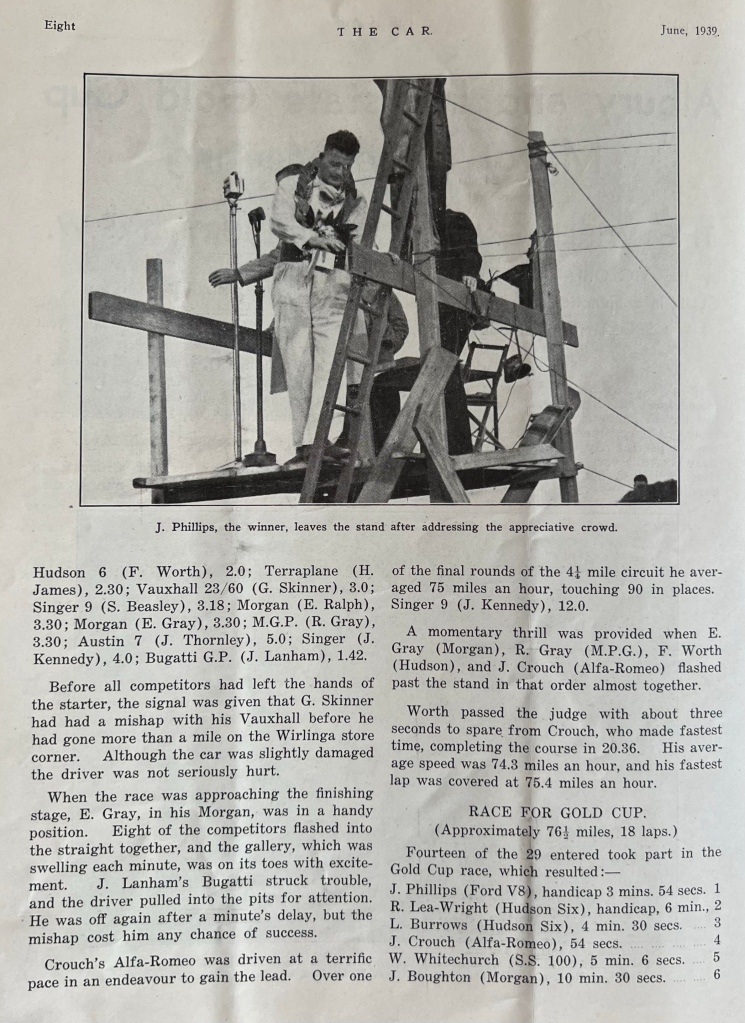
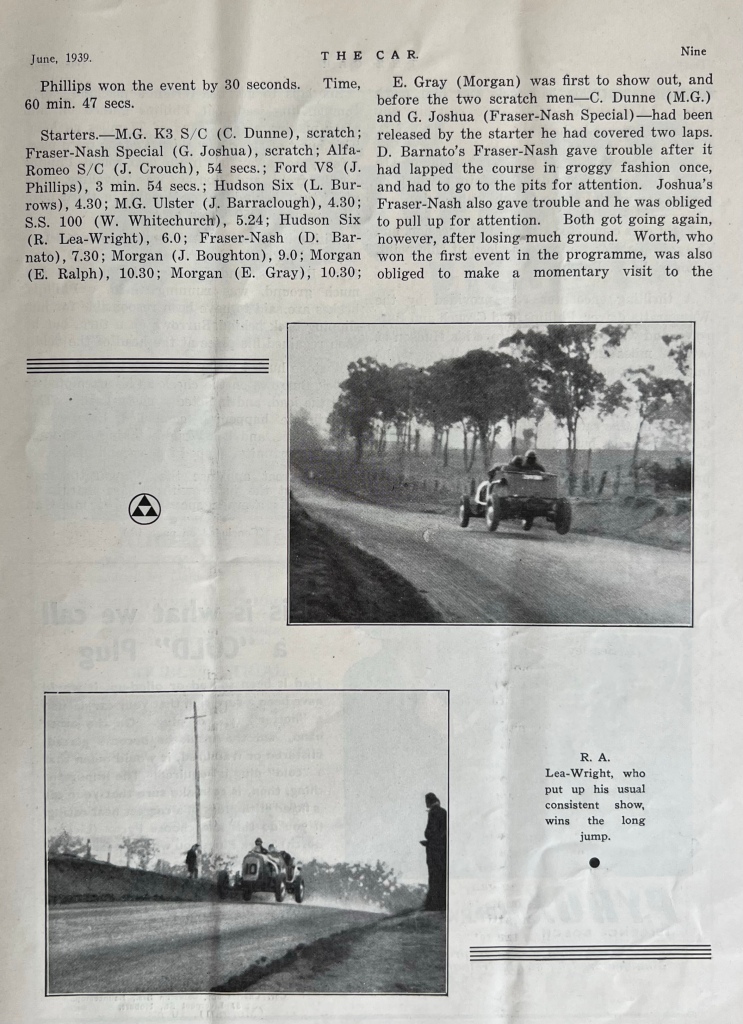
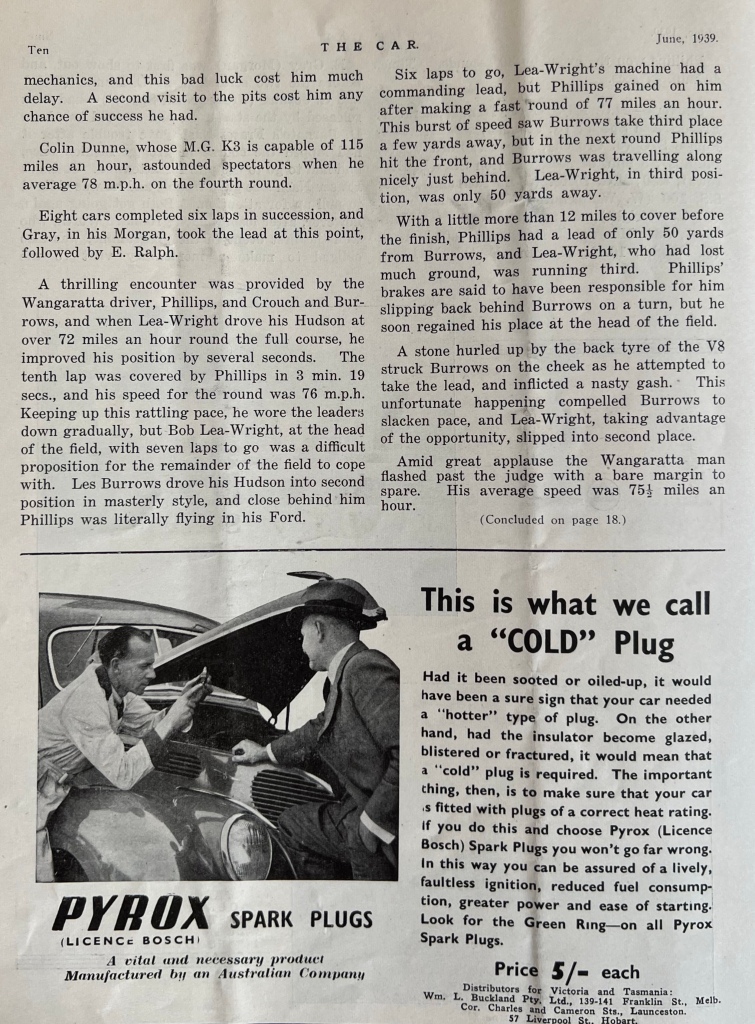
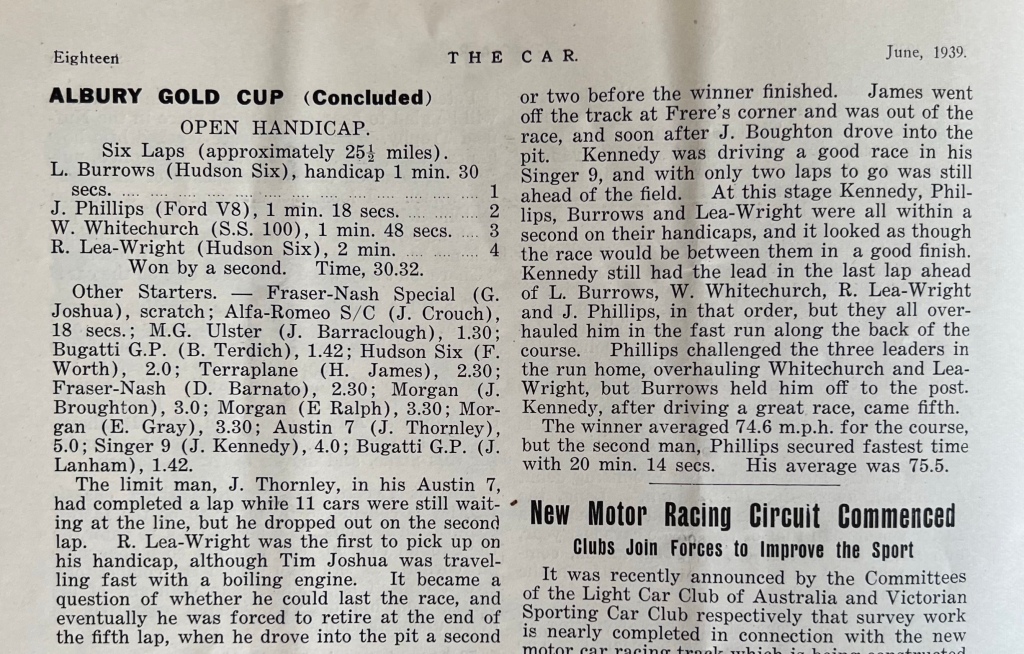

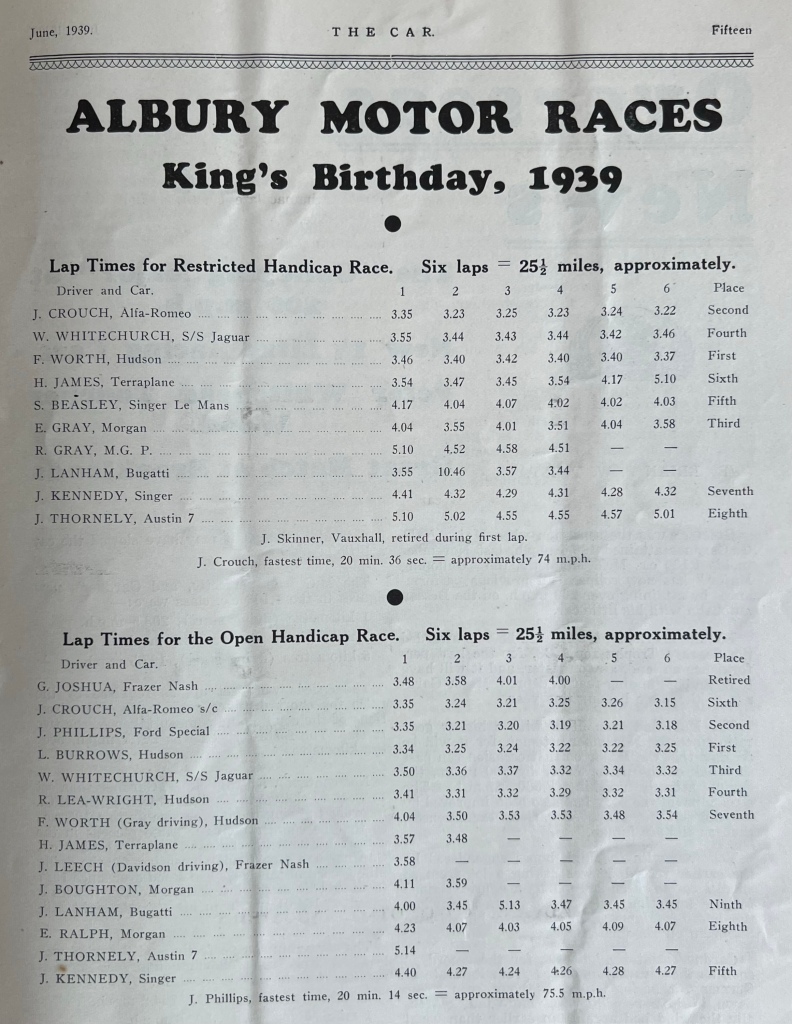
Credits..
The Car June 1939 via the Bob King Collection…
Finito…







Credits..
The Car June 1939 via the Bob King Collection…
Finito…

The Jack Phillips – Ted Parsons 1934 Ford V8 was Australia’s fastest of the breed pre-war. Here the machine is aviating on the Wirlinga road circuit – 10km northeast of Albury – on the Kings Birthday weekend in June 1940. The duo are on what was then called Orphanage Lane (now St Johns Road), the two crests which allowed the cars to take to the sky were near Corrys Road, Thurgoona, many thanks John Medley and Ray Bell.
The car was one of the most successful of all Australian racing cars in the immediate lead up to the conflict, placing sixth and third in the 1938 and 1939 Australian Grands Prix at Bathurst and Lobethal respectively. “In Victoria for the 1937-38 season, the Phillips Ford was awarded ‘The Car Trophy’ for the most successful competitor,” John Medley wrote.
The duo also won the Interstate Grand Prix/Albury and Interstate Cup on the Albury-Wirlinga road course in 1938-39 and the South Australian 100 at Lobethal in January 1940. On the same day the pair finished second to Les Burrows’ Hudson Terraplane Special in the Lobethal 50.

As the lights were progressively turned down throughout 1940, the Phillips/Parsons pair were ninth in the Easter Bathurst 150 mile race won by Alf Barrett’s Alfa Romeo Monza. The car’s final meeting before being put on display for much of the conflict in their Wangaratta Motors Ford dealership was the 75 mile Albury and Interstate Cup Race on June 17, 1940. It was the final meeting on this road course and Barrett set the all-time lap record at 2 minutes 52 seconds but broke an axle and retired from the race. Harry James’ Terraplane won in a steady performance from John Crouch’s Alfa Romeo 8C2300 Le Mans with Phillips/Parsons third.

Based on a fire-damaged ‘34 sedan with over 20,000 miles on the clock, the car was modified in the partner’s Wangaratta, Victoria Ford dealership by fitment of a special, swoopy, lighter body. Engine enhancements included twin Winfield carburettors, Scintilla magneto, modified heads and free-flowing exhausts.
Timed at 115mph in top gear, it did 80 in second – at a then heady 6000rpm – using the 3.5:1 rear axle ratio. It was a paragon of solid reliability too, not suffering the overheating afflictions of so many modified Ford flatties.

John Medley observed the car’s strengths, “The Phillips Ford simply soldiered on in prewar races on dirt and gravel roads, built tough to last to the finish. It continued to race postwar particularly in Victoria and South Australia where it was raced by South Australian Granton Harrison, by which time the newer breed of generally smaller and lighter V8 Specials could out-pace it.”
“Still it had been the mould in which the later V8s were shaped. In the postwar period, with T-Series MGs, Ford V8 specials were the backbone of Australian road racing.”
The Phillips/Parsons Ford was destroyed when it was crashed into a bridge, the remains were scrapped. Ted Parsons Jnr and his son Rob recreated the car between 2008-2014, the car took its bow at Winton in 2014.

Historian, Rob Bartholomaeus has worked out, by looking at his photographic archive, that a rebuild involving lightening and lowering the car and replacing the ’34 grille with a 1935 unit and a change in colour scheme from the one above, to the diagonal stripes shown in most of the other shots was made in late 1938 rather than 1937 as documented elsewhere. It seems the car started with underbody exhausts, then evolved to the side exhausts as above which were retained after the car was modified and repainted.
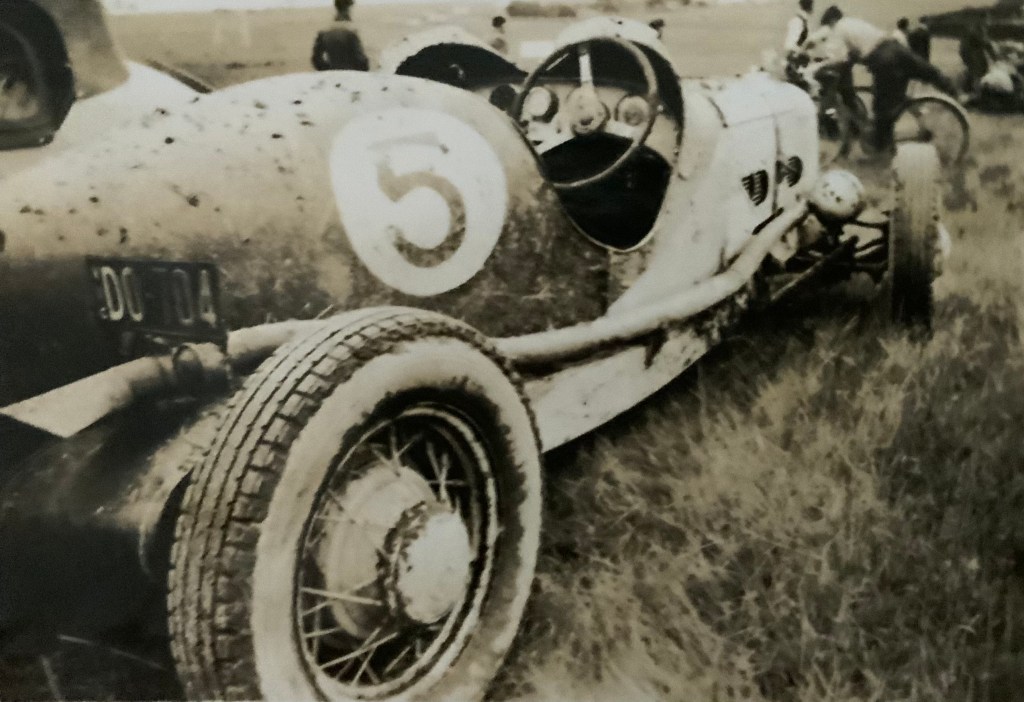
As noted above, the car’s last pre-war meeting was at Wirlinga in 1940. Bob King has this photograph in his collection, the caption on the back lists the racer as Bill Sinclair and the place, Oakleigh in 1942. I can find no Trove reference to this meeting at what is now a southern suburb of Melbourne. It appears as though the car is running the same number/roundel combination from Wirlinga, quite probably untouched. If anybody has information about the event do get in touch.

It’s not clear when Granton Harrison bought the machine but he added to its tally of Australian Grands Prix entries, racing it at Point Cook to Melbourne’s west in 1948, where he placed fourth, and in 1950 at Nuriootpa in South Australia’s Barossa Valley where he was 11th in the race won by Doug Whiteford’s Ford V8 Special ‘Black Bess’, Bess was inspired by the Ossie Cranston and Phillips/Parsons Ford V8s.
The shot above is of Granton contesting the South Australian 100 at Lobethal on New Years Day, 1948. A good day for him too, he was second behind Jim Gullan’s Ballot Oldsmobile Special – and did fastest race time in the handicap event – continuing this car’s reputation for competitive reliability.
Back to the sequence of owners. Stephen Dalton has Granton advertising the car for sale in the February 1948 issue of Australian Motor Sports, with Jack O’Dea running it at Rob Roy in January 1949, perhaps Jack ran it as a borrow/view to purchase. As we can see Granton raced on for a couple of years after that, if anyone can help with the ownership sequence, do get in touch.

Etcetera: The Warren Safety Aviation Helmet…
WT Warren invented the Warren Safety Helmet in 1912. The spring-equipped pilot safety helmet, made of leather and cork with vented ear collars was padded with horse hair and designed to minimise head injuries, the major cause of aero accident deaths at the time. The helmet was part of RAF listed kit issue from 1920-24.
Later models incorporated an ear audio piece and a breathing mask. By the time Phillips and Parsons used them they had been pensioned off by the RAF. Curtis and Taut & Co made the helmets under licence, the inscription in Parsons’ helmet, retained by the family, reads ‘No 2 Tuatz & Co Patent 17855 Aviators Safety Helmet. Maker Tautz & Co, Hunting Military and Multifit Tailors, 12 Grafton St, New Bond St, London.’

Rob Parsons explained further, “While the helmet was obsolete for aircraft, they were used by Phillips and Parsons from 1935-39. With a lack of sporting regulations, these cars lacked the safety features of safety belts which were not considered a benefit for car racing. Drivers had a steering wheel and the co-driver a grab handle to hold onto. It would be common in rollovers to duck-down and brace yourself, perhaps to be trapped or otherwise flung free of the car, all with grave consequences.”
“Ted Parsons first introduction to motor racing was at the Benalla Airstrip circuit, perhaps a likely place to find such a helmet. On the back page of his photo album, he list drivers who died racing during his involvement, a reminder of the sport’s dangers. He retired from racing after the war to pursue golf and film-making.”
“Jack and Ted wore leather face shields to protect themselves from their own flying stones and other track debris, an idea adapted from the oxygen flying mask. The leather was painted white to match the colour of the car, aviation goggles protected their eyes,” Parsons wrote.
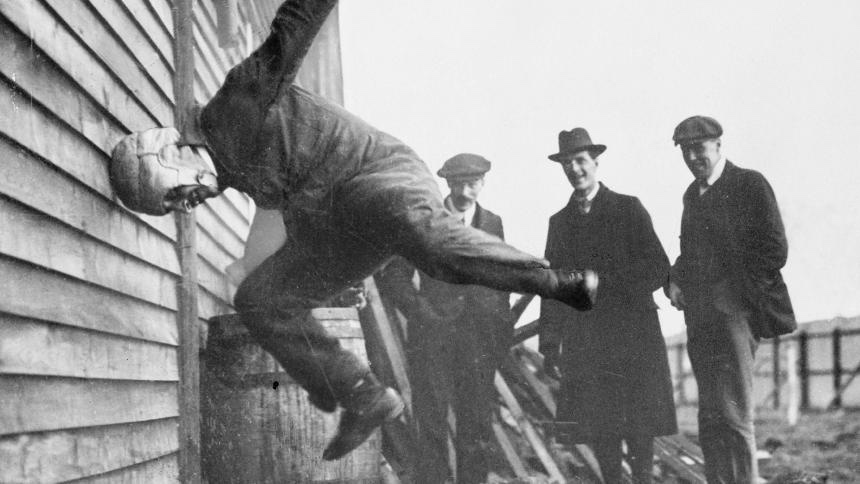
WT Warren tests his new helmet – as one does – by headbutting the wall of William Ewen’s Hendon flying school, where Warren was a trainee, in 1912.
What follows is the German-English translation from an article in Der Spiegel.
“In a 1912 issue of Flight magazine, British inventor WT Warren’s invention, a protective flight helmet is demonstrated. The image is often erroneously reported to be a football helmet.”
‘The wall against which the helmet carrier ran belongs to the flying school of William Hugh Ewen. The owner (middle) and and his chief pilot LWF Turner (left) are behind. The Lord in the foreground is his student Mr WT Warren. And, no, he has not failed the flight test and is just reacting to his anger.” Clearly the German hilarity is lost in translation.
“Dated 1912, Mr Warren is a tinkerer. He introduced his latest invention to experienced pilots: a protective helmet ‘that will attract considerable attention’, Flight magazine wrote. Warren’s leather cap was padded with horsehair: A system of steel springs should intercept any impact, thus reducing the risk of injury. Head injuries were the leading cause of death in flight accidents.”
Credits…
‘John Snow:Classic Motor Racer’ John Medley, State Library of Western Australia, cars4starters.com.au, Bob King Collection, ‘The Warren Safety Aviation Helmet’ by Rob Parsons in the July 2021 issue of ‘The Light Shaft’ – Austin 7 Club magazine, Parsons Family Collection via austin7club.org, John Dallinger, Der Spiegel
Tailpiece…
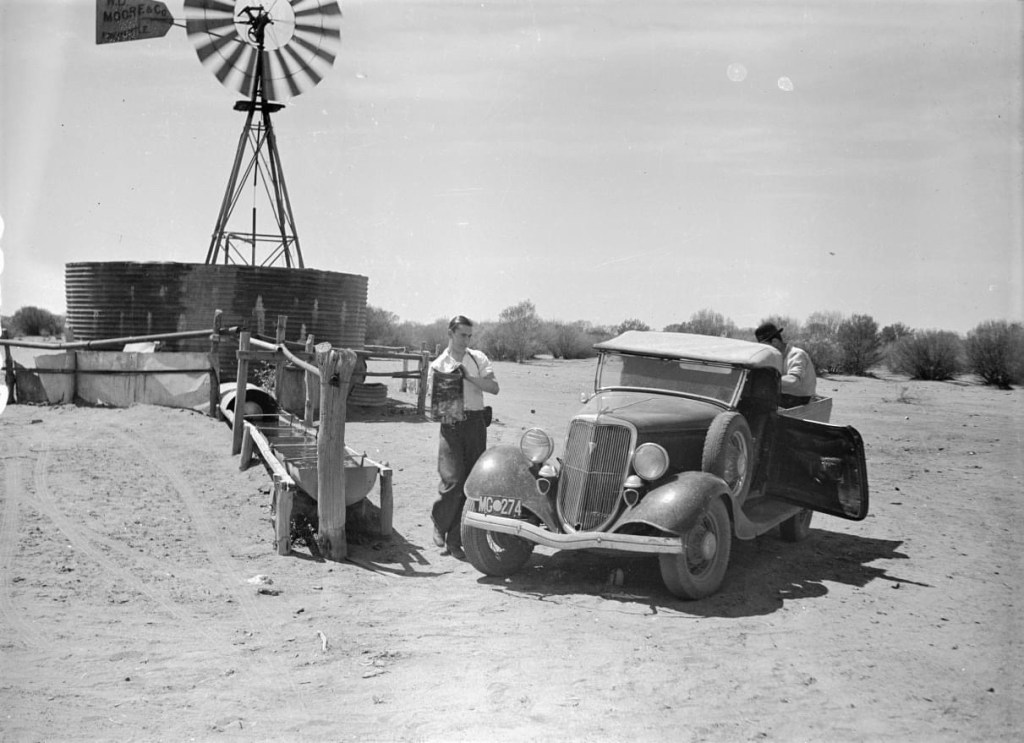
I’m cheating a bit, this 1934 Ford is a V8 ute rather than a sedan, but you get the jist of it.
The Phillips-Parsons racer was not too far removed from a roadie, rather than an out-and-out bespoke racer, reliant as it was on the standard chassis, axles wheel to wheel, differential and gearbox.
The ute is singing for its supper, doing a meat delivery in country Western Australia in 1937.
Finito…
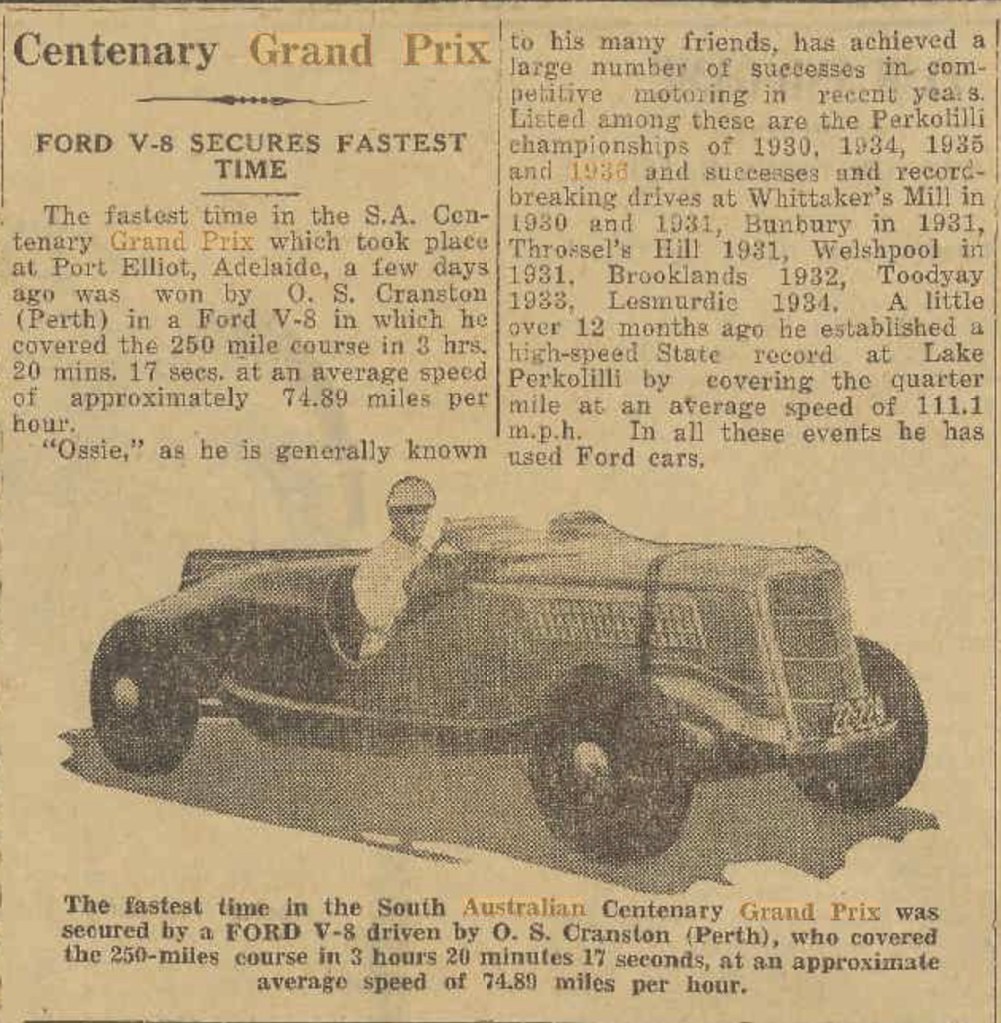
Osborne Scott ‘Ossie’ Cranston (1899 or 1903 – July 1, 1982) was one of Western Australia’s aces at a time Perth was a long way from the eastern seaboard (sic).
To race his Ford V8 Special in the December 26, 1936 South Australian Centenary Grand Prix (the 1936 Australian Grand Prix) at Victor Harbor required shipping his car on the interstate passenger liner, the Manoora, on the Tuesday before the race, from Fremantle to Port Adelaide. A trip to Melbourne is a lot further and Sydney even more. So race-fans in the more populous states of the nascent country of Australia didn’t see many of the faster West Australian cars, despite their thriving motoring scene.

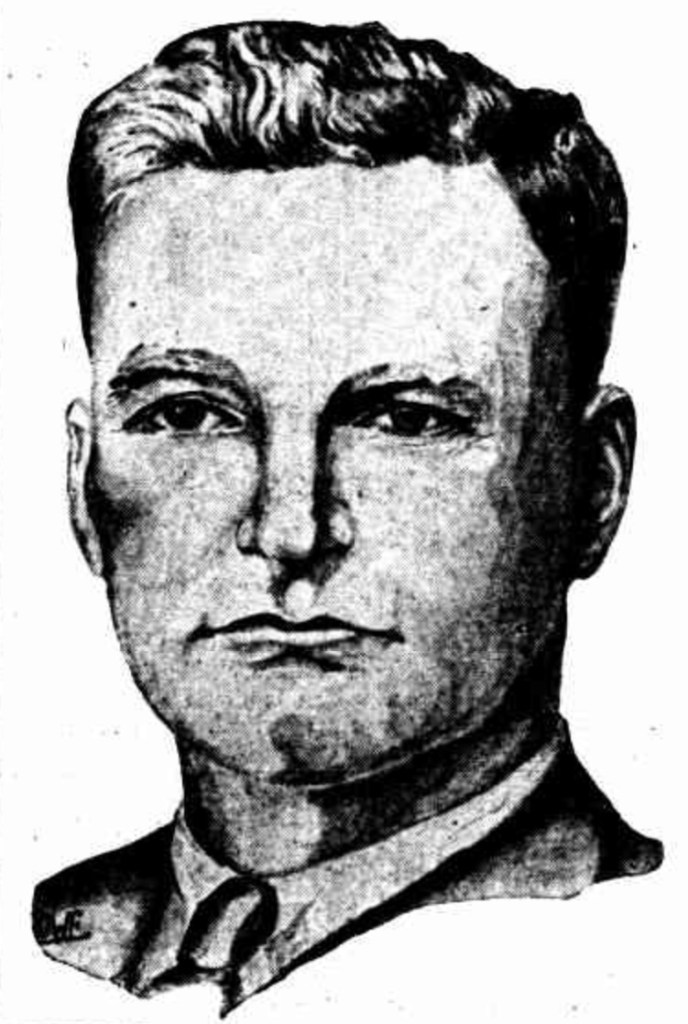
In that sense, Cranston’s Victor Harbor (correct spelling) achievement was a great one over the more fancied Bugatti T37As, MG K3s, Frank Kleinig’s Kirby Deering Special and Hudson Special (he raced the latter) and Jack Phillips’ Ford V8 Special. Not that Cranston won the race.
Australian Grands Prix, until the dawn of the 1950s, were handicap events given the shortage of racing cars spread across a huge space – Australia is a big joint, have a look at a map one day – and the vast disparity in performance between those cars. Cranston did the fastest elapsed time but finished sixth on handicap. Les Murphy won the 250 mile race in an MG P-Type. See here for a long epic on this race around a rectangular 7 4/5 mile, sandy-gravel course, between Victor Harbor and Port Elliot. ‘South Australian Centenary Grand Prix’ 26 December 1936 aka 1937 Australian Grand Prix…… | primotipo…


Cranston’s car started life as a 1935 model (1933 in some references) Ford V8 utility. It was then modified with a light racing body – the long tapered body with fin atop was fitted in 1935 – magneto ignition, competition exhaust manifold, flattened road springs and two Winfield carburettors in place of the single standard item. “Otherwise”, the ‘papers of the day reported, “the car is identical with the Ford V8s sold by Lynas Motors Ltd”, the Hay Street, Perth, Ford dealership of which Cranston was a partner/shareholder with V Lynas and J Victor Pascoe. Later fitted the with a ’36-model radiator, it was then erroneously and continuously called a ‘1936 car’.
I won’t repeat the successes of the car at Lake Perkolilli and other Western Australia venues already outlined in the opening image.
Cranston grew up in the comfortable surroundings of Swanbourne Beach. He began his working career as an apprentice mechanic with Grave and Dyer, working on Standard and Imperial cars. The business was Perth’s first Ford Dealer, over 15 years he rose through the ranks to become Works Manager. From there, Cranston was recruited by Ford as Works Superintendent of their assembly plant at North Fremantle. Later, he and his partners, former colleagues from Grave and Dyer, formed Lynas Motors Ltd.

In 1917 (or 1919) Ossie took up motorcycle racing, he won his first competitive race, the three-mile Charity Handicap at the WACA, riding a Triumph “in a brilliant performance for a novice.” He raced mainly on the grass tracks at Claremont Showground, Loton Park and on the road riding Indians and Triumphs for the Armstrong Cycle and Motor Agency. Six track/road championships followed, one “was recognised by Triumph in England with a gold medal and a particularly eulogistic letter of appreciation,” the Sunday Times wrote.
A large crash at Claremont in 1922 encouraged a shift to four-wheels. While still at Grave and Dwyer, he initially drove a Ford Model-T in hillclimbs, setting many fastest times in a car affectionately nicknamed ‘Heza Henry’. Hez had a hand-formed, torpedo-shaped rear which incorporated ‘guards for the road which were removed for competition work. It did 68mpg on the Perkolilli claypan in 1927.
With the introduction of the Model-A, Ossie built up ‘Cactus’. It had a less refined vinyl boat-tail body than Heza, from the dashboard back, two bucket seats and a fairing in front of the driver. Various engines were fitted along the way but the body was a constant.
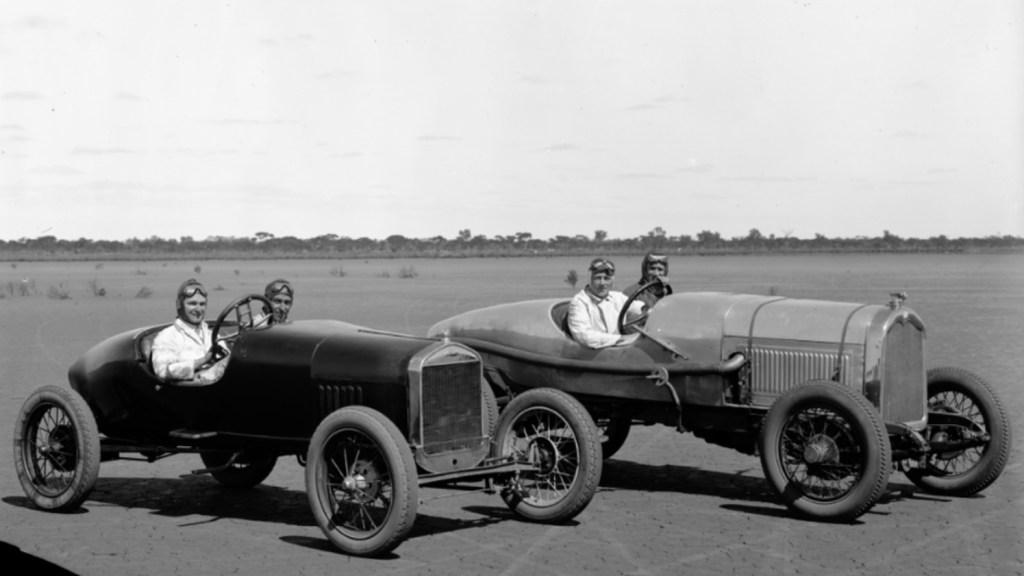
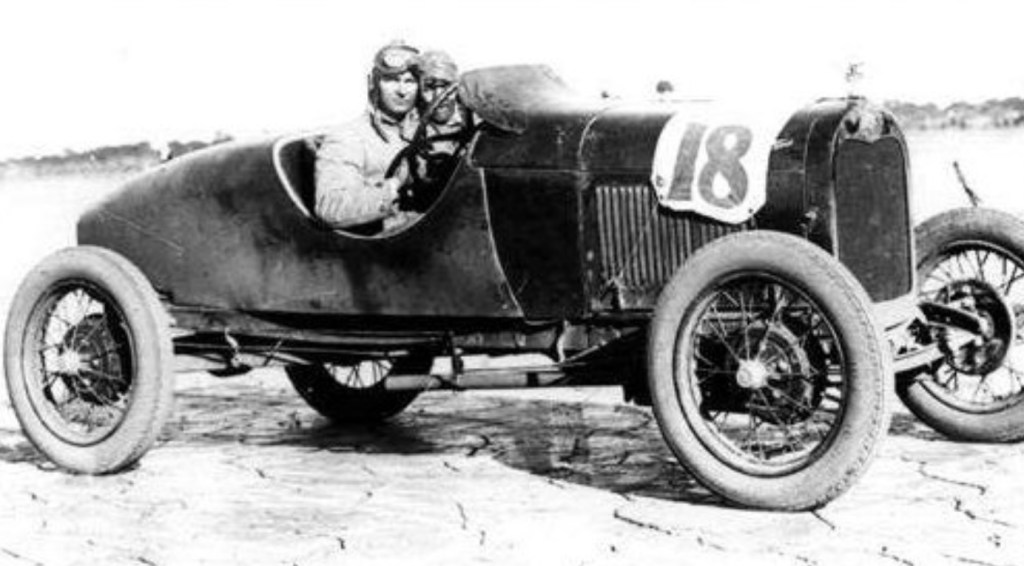
Well suited to hillclimbing but not so much Perkolilli’s long curves, he still finished third behind the Armstrong driven Auburn and Colliver Chrysler in the RACWA State 20 Mile Championship in 1929. He won the 10 Mile handicap that day too, claiming that the car was capable of 100mph. Cranston went one better in 1930 taking 10 Mile Lake Perkolilli State Championship.
The 3.3-litre, four cylinder, side-valve – for a while supercharged – engine had a range of modifications to the cylinder head, carburetors, intake and exhaust systems and a taller top (third) gear fitted to Ford’s coupe.
Further success ensued throughout 1931-32 at Whittakers Hill, North Dandalup, Lake Pinjar, Bunbury Beach, and Whittakers and Greenmount Hills. By late 1931 Cactus maxxed out at 89 mph to win the flying quarter-mile event at Wattle Grove.
In 1932 the Brooklands Speedway opened (on the West Subiaco aerodrome site), where Perry Lakes and the Uni WA sportsgrounds are today. Brooklyn had only a short commercial life, but Cranston – belted pretty hard by the handicappers – set a four-lap record for the one-mile, limestone track in 4 mins 38 secs in 1932, not too long before Cactus was retired.
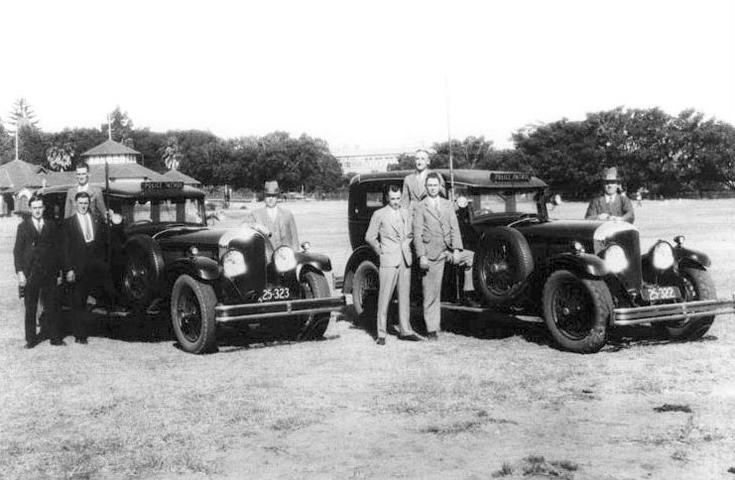
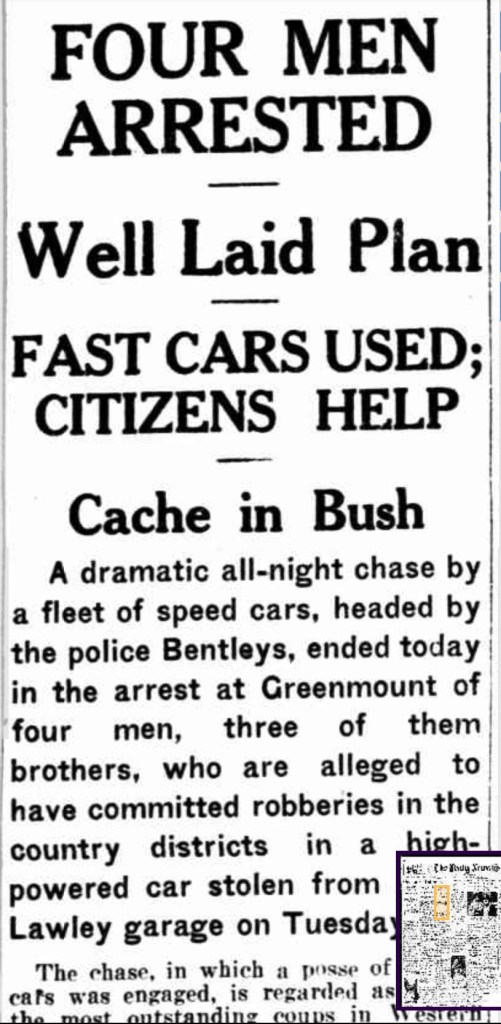
One of the more bizarre days of Cranston’s long life was a police invitation for he and Cactus to join a posse of cars to help catch some baddies in September 1933. Said crooks were committing smash and grab robberies in the country, then escaping in a stolen, fast, ‘high powered car’.
The police generals figured they needed more pursuit cars capable of in excess of 80mph, than their two 6.5-litre Bentley Speed Sixes. Yes folks, the WA police were the only wallopers on the planet to have these expensive blue-bloods as patrol cars. The plan was to create a cordon around Perth to chase down and catch the dirty-rats. So, some racers were recruited as Deputy Sherriffs including OS Cranston.
While Cactus wasn’t involved in a high speed chase, the four-perps (police talk I believe) ran off the road alongside where Cactus was parked, near the gate of the national park at Greenmount (23km east of Perth). They were arrested with a cache of stolen goods found close by.
In another bizarre, only-in-Australia moment, the handcuffed crooks were kept warm beside a fire lit by the coppers while Cranston high-tailed it back to Perth in Cactus. The Bentleys had radios, no other WA police cars did, Ossie’s mission was to give the good news to senior police and organise a patrol car to take the shaken, but warm robbers back to the city lock-up…
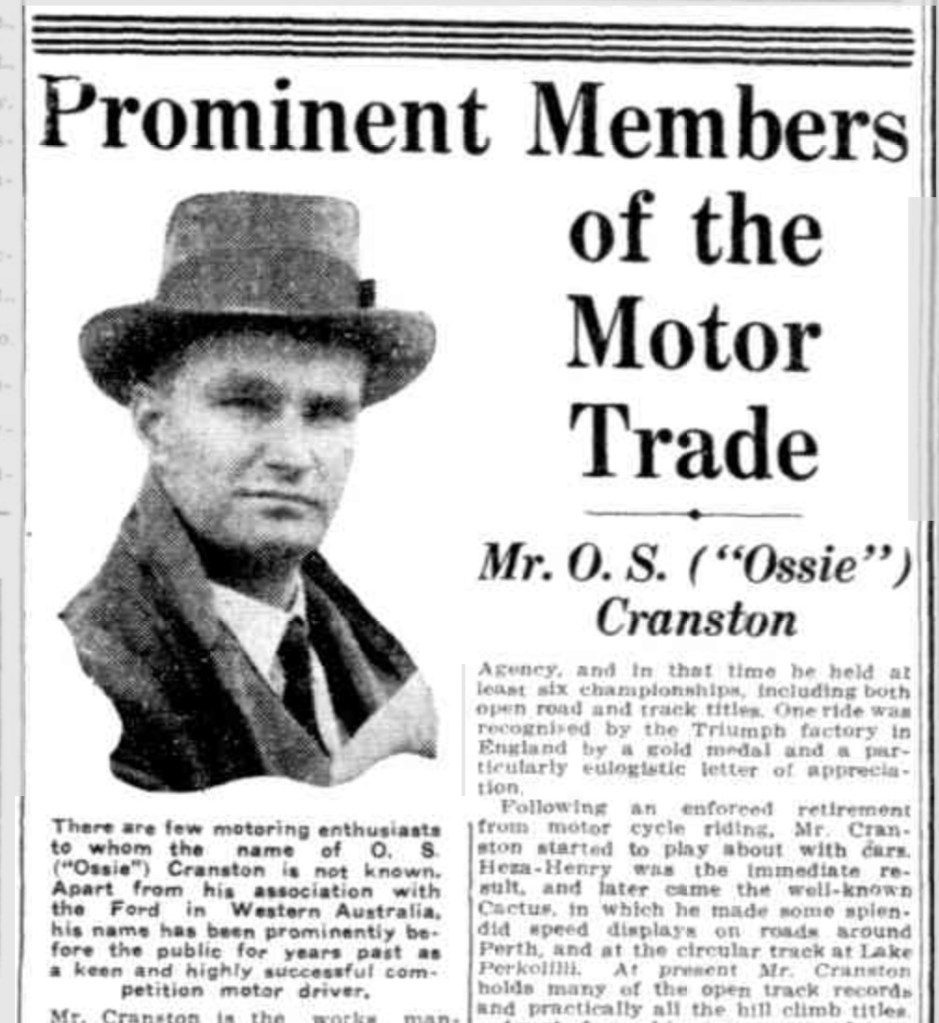
By 1934 Cranston was quite the man about town too. In addition to his Lynas responsibilities he was a director of Rural Motors Ltd, Bunbury Motor Estates Ltd and General Investment Co Ltd, which provided consumer finance for Fords. He was also the director of several companies outside the motor trade.
Wearing his Lynas Motors hat Ossie travelled to ‘The Orient’ (is that term a no-no these days, one never hears it used?) in mid-1934. “Wherever you go you’ll see a Ford,” he quipped to the Perth Mirror on his return.
Cranston was amazed by the number of baby Fords in Singapore and amused that the first news he received in Ceylon was about the success of a small Ford in a local hillclimb. In Java he observed that cars were ancient, “the post Depression prices of sugar and rubber are low.”
Things were better in Singapore, Shanghai and Hong Kong. Siam made the railways pay, “with no roads between the principal centres people are forced to use the trains!”
Asked about the new Datson (sic, the machine would have been the Datsun – Nissan – Type 13) car, “a new light job similar to the 7hp units with which we are all familiar, being built in Japan.” Cranston said “I didn’t see one on the trip. Agents have been appointed in various centres of the orient, but it’s unlikely any are expected in Australia.” Not for three decades or so, in any event!
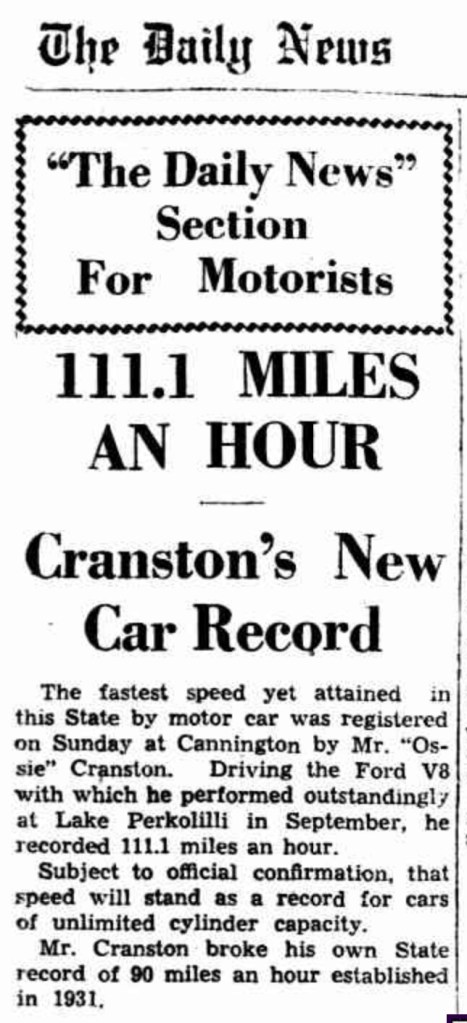

In 1934 Cranston returned to racing with the Ford V8, setting a new Australian record at Perkolilli over 10 miles (16 kilometres) at an average speed of 97.61mph (157 km/h), and later a new State record of 111.1mph (178.8km/h) over a flying quarter-mile on Nicholson Road, Cannington, beating the record set in the Model-A.
After success in the South Australian Centenary Grand Prix, held at Victor Cranston told the Motorist and Wheelman that he was retiring from racing because he was “too old”.
Ford recognised his contribution to the sport and polishing the marque’s brand via his racing exploits over a long period with the presentation of a ‘gold wristlet’ at a function of dealers in Perth in April 1937.
His final motor racing event – just before the lights-went-out in WW2 – was the Patriotic Grand Prix, held on the Applecross streets of Perth in November 1940.
Following Cranston’s decision to retire, he sold the Ford V8 racer to Bathurst Ford dealer and 1920-30s intercity record breaker Norman Aubin. John Medley wrote that Aubin prepared the cream and green car for 27-year-old local driver, George Reed to race in the 1938 AGP held at Bathurst.
Reed’s race was brief as the big car spat its fan through the radiator early on. It would be interesting to know what the young driver thought of Cranston’s car. He was to build some very fine Ford V8 Specials of his own, including the George Reed Special Warwick Pratley raced to AGP victory around-the-houses at Narrogin, Western Australia in 1951.
The ’38 AGP was won by British international Peter Whitehead’s ERA B-Type. After that Easter meeting, Aubin sold it to a Sydney buyer, who repainted it red, but it never raced again.
Another report has it that the car was sold to an eastern states competitor who was killed in it at Bathurst. The engine was fitted to a speedboat and the chassis stored for a bit before being destroyed. Does anybody know the facts?
In 1983 Clem Dwyer started the build of a replica which remains a welcome competitor in historic events.

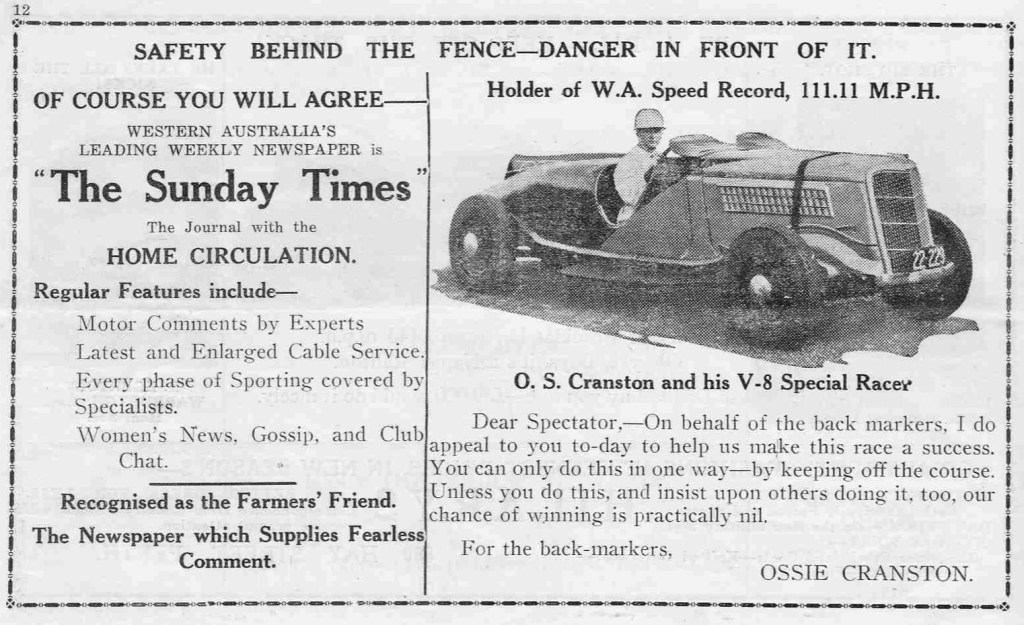
Cranston hadn’t lost his passion for motorsport though. He had built ‘Miss Frances’, a Ford V8 powered speedboat which generally “spreadeagled rivals in much the same fashion as he had been doing for years on the terrain.”
“When not tied up with one or other of the multitudinous business matters which occupy his attention, Mt Cranston golfs, his one vice.” There was another though, with the encouragement of his wife he commenced horse riding at about 40. So keen and proficient was the Mosman Park resident, that he became Master of The Hounds for the West Australian Hunt Club.
Ossie remained involved and close to motorsport. An Ossie Cranston Trophy was contested in West Australian Sporting Car Club events for years, Cranston was a stalwart of the club, formed on November 17, 1929. Together with Eric Armstrong, CS Dyer and Claude McKinley he kept the very successful organisation together in some of its more difficult years.
Cranston was ‘the official driver’ at Caversham (first used on March 13, 1948) and into the 1970s at Wanneroo Park. He died on July 1, 1982 – born in either 1899 or 1903 – his remains are at the Karrakatta Cemetery in Perth.
PS; Most of this piece was written via extractions from period newspapers. Of their nature they are light-on with the specifications of the cars. If any of you can assist in that regard, or in fleshing out Ossie’s story, do get in touch.
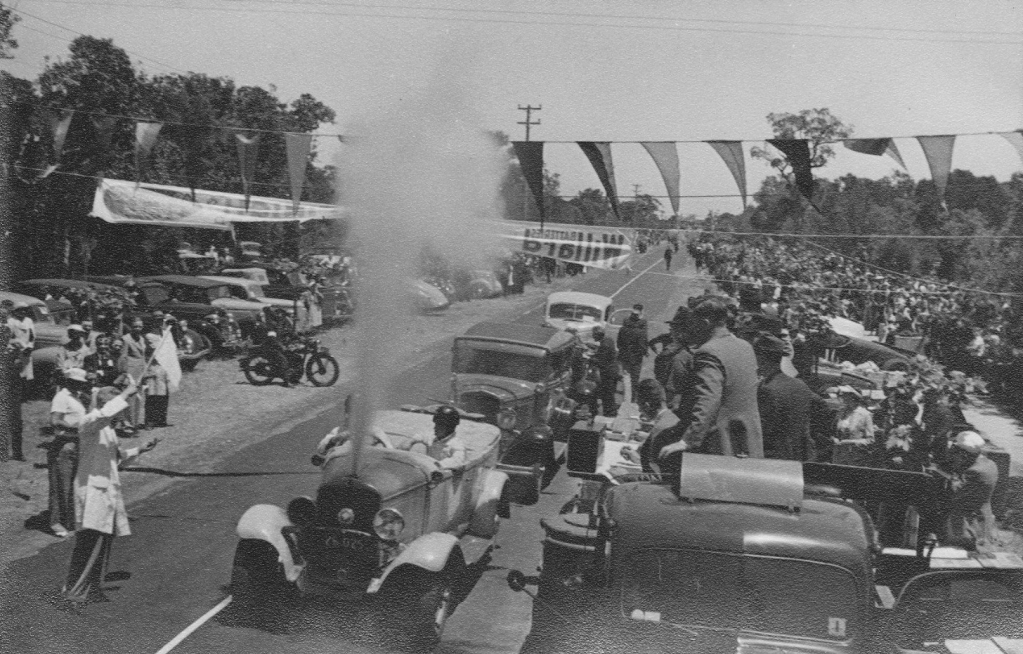
Etcetera…
It’s a Gas
Pretty much the final motor race of any size in Australia before motorsport was set aside for the duration of World War 2 was the Patriotic GP, attended by a “huge crowd” at Applecross on November 11, 1940.
In his return to racing, Cranston ran a ’38 Ford in the novel, Producer Gas Race for stock, or standard cars. Ossie finished second in this handicap behind WJ Stitt’s De Soto straight-eight.
Interesting, perhaps – in the context of fuels of quite dissimilar quality, and the use of gas to power cars during the conflict – is the difference in performance between Ron Possetts’s petrol fuelled ’39 Ford V8, which won the stock (standard) car race and Ossie’s machine. Possett’s (rated a very good driver) best lap was 3 min 12 sec, and Cranston’s 3.44.
“The hilly course was a good test, the contest admirably fullfilled its purpose, which was to demonstrate that the sacrifice of performance made by the use of producer gas, is small,” wrote the South Western Advertiser.
The ‘Tisers’s journo continued, “A most interesting feature of Cranston’s car was that the ‘gas-works’ were all enclosed; producer, cleaners, pipes etc were all hidden, in the luggage trunk, beneath the bonnet or under the floorboards, and, except for cooling-louvres in the lid of the rear compartment, the big modern sedan had the appearance of a standard petrol model.”
All we need now is a happy-snap of the car, can anyone oblige?
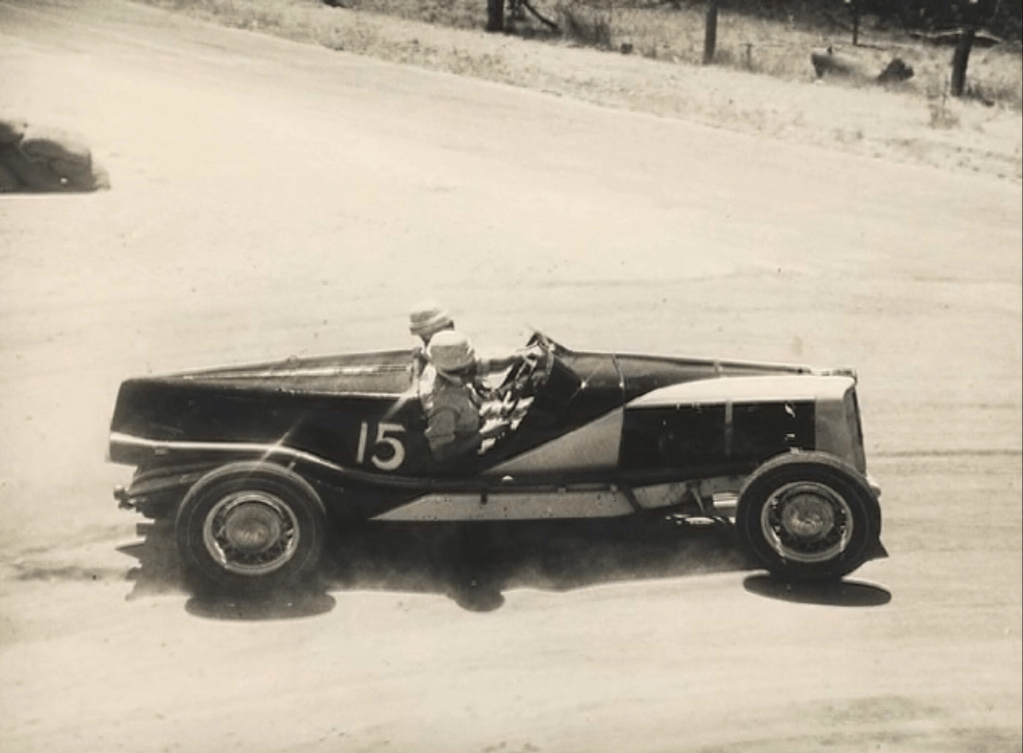
Top Gun?
Looking at the performance of Ossie’s car, it has to be a contender for fastest-best Australian Ford V8 racer in that pre-war period?
Jack K Phillips’ similar machine (above) has to be in the mix too. He too was a Ford dealer, in Wangaratta, Victoria. Yep, I’ve heard of Black Bess, while built pre-war, Whiteford didn’t get her performing well until after the conflict.
The Cranston and Phillips cars were Special Ford V8s rather than Ford V8 Specials. That is they were modified Fords, rather than a concoction of parts of various makes powered by modified Ford V8s.
I’m interested to hear from those of you who know about such things, which car was the quickest-best Ford V8, and quickest-best Ford V8 Spl pre-war?

1936 Australian Grand Prix
I’ve got my great mate, Tony Johns, to thank for the wonderful loss of a couple of days researching this piece.
During his weekly State Library of Victoria research visitations, Tony came upon a snippet about the Light Car Club’s endeavours to run the 1936 AGP on a road course at Mornington, then a quiet, seaside village, 70km from Melbourne.
The Phillip Island road course which hosted the AGP from 1928-1935 was on-the-nose given its dangerous nature for cars of less than 2-litres, let alone the unlimited cars which should also have been included in the fun.
I’ll get to Mornington in due course.
There was no AGP called, promoted and run as such during 1936. The December 26, 1936 South Australian Centenary Grand Prix was later appropriated as an AGP – I’ve no issue with that – but the nincompoop(s) who did so, determined that a race held in 1936 was the 1937 Australian Grand Prix. WTF etc.
I’m on a one-man crusade to right this wrong, that is, the 1936 AGP event was the one at Victor. There was no AGP called, promoted and run as such in 1937 either. If we want to anoint one significant race held in 1937 as a part of the pantheon of AGP’s I’ve an open mind, send me your ideas and justifications…See here; 1936 Australian Grand Prix, Victor Harbour… | primotipo…
Anyway, in Troving (Trove is a digital record of Oz newspapers) with search-words like ‘Mornington 1936 Australian Grand Prix’, up popped the article which starts this piece. I’ve very much enjoyed writing it, knowing little about Mr Cranston and his achievements two days ago…
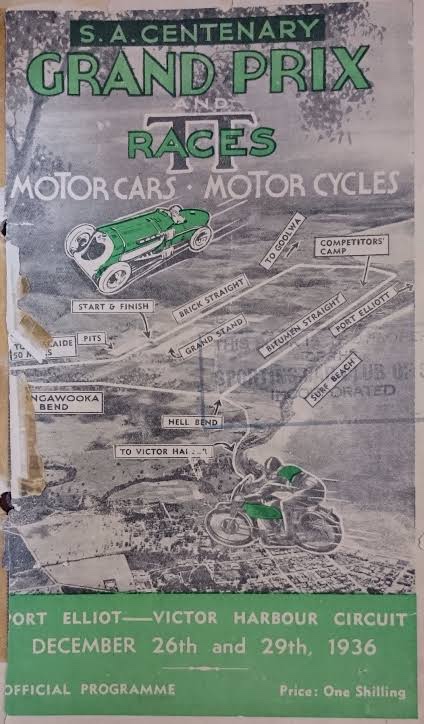
Port Victor
The poor old South Australians can’t make their minds up about Victor Harbor.
We Australians adopted the Pom’s version of English on the basis that as they invented it they should have half-a-clue about how stuff should be spelt.
Despite that, the township of Victor Harbor, rather than Victor Harbour, was proclaimed in 1914, for reasons almost as obscure as those related to the year in which the 1936 AGP was held.
Clearly the author of the South Australian Centenary meeting programme was confused too. Despite the race being held in Victor Harbor, the event was contested, seemingly, on the Port Elliott-Victor Harbour Circuit.
Credits…
The Blackwood Times, Friday January 15, 1937, Sunday Times Perth June 30, 1935, Mirror Perth July 7, 1934, Kalgoorlie Miner, various many other newspapers via Trove, ‘Cactus-Work in Progress’ Graeme Cocks, State Library of WA, ‘Bathurst: Cradle of Australian Motor Racing’ John Medley, Ken Devine Collection, vintagebentleys.org, Norman Howard, Rob Bartholomaeus Collection, Bob King

Tailpiece…
When you’ve spent a good chunk of your annual capex-budget on a couple of Bentleys, the Perth Polizia PR department worked the local papers hard to ensure the Bentley Patrol bagged as much of the crime-solution-limelight as possible, however tenuous the connection between the misdemeanor and WO’s finest.
Doubtless the lissom Subiaco lass slept easy knowing the Bentleys were prowling the streets with as much stealth as Merv the Perve…
Finito…
Jack Phillips and Ted Parsons looking happy with themselves aboard their Ford V8 Special having won the Interstate Grand Prix at Wirlinga, Albury on 19 March 1938.
The Ford V8 found its way into all kinds of Australian specials both pre and post war, this was one of the most beautifully built and successful of them all. See here for a piece on this race; https://primotipo.com/2019/01/11/interstate-grand-prix-wirlinga-albury-1938/
These two mates were business partners in a motor dealership in Wangaratta which distributed Ford and other brands. I wonder if one of the admiring, capped kids is Jack’s son Ron Phillips who was a star in an Austin Healey 100S and Cooper T38 Jaguar in the mid-fifties to early sixties?
It’s pretty boring writing about familiar stuff, the journey of discovery is far more engaging. I think a lot about racing in the context of the times, how people lived, what they did with their leisure hours but it’s not necessarily easy to find the right photographs.
Not so this time, John J ‘Jack’ Dallinger ran a photography business, which still exists in Albury. Along the way, he and his staff recorded the daily lives of the citizens of the border city and surrounds, I’ve chosen some images of typical life justaposed with racing shots. All of the photographs were taken by Dallinger and his team in Albury in the thirties, unless attributed otherwise.

Locomotive’3623’ leaves Albury Station during the thirties. Obviously some sort of special occasion for the train to be decorated as it is

Albury Show wood-chopping competition, takes me back to watching the O’Toole brothers on Channel 7’s Sunday ‘World of Sport’ in the sixties
Motorcycle racing blazed the trail for cars in just about every sphere of competition in Australia, speedways included.
This is Aub Boyton aboard a Douglas, perhaps a 500cc DT5 or DT6- Douglas being one of the most popular and successful speedway bikes of the era.
Jim Boughton, Morgan at Wirlinga in 1938.
A year later this car had morphed into a single-seater in time for the Australian Grand Prix at Lobethal the following January, he failed to finish the race won by Allan Tomlinson’s MG TA Spl s/c. Better still, the Morgan remains extant.
Out and about in an Austin 7, this one is fitted with a James Flood built two seater sports body.
Of all steel and ash construction, the machine used a factory supplied radiator cowling forward of which was a fairing covering dummy dumb irons onto which was painted the registration number. The running gear comprised a production Austin chassis and mechanicals with a raked steering column.
Large flowing wings kept the elements from the occupants. ‘As was fashionable with many Australian models of this period, fixed split front windscreens were mounted on the scuttle with no provision of any weather protection’, many thanks to Tony Johns on this little Austin.
Keen spectators taking a look at competitors in the Wirlinga paddock prior to the 1938 Interstate Grand Prix.
Car #3 is Tim Joshua’s Frazer Nash, not too far from being restored, alongside is former Maroubra ace Hope Bartlett’s MG Q Type and then car #6, the winning Ford V8 Spl of Phillips/Parsons.
Billycart race in Pemberton Street, Albury 1940s.
Too much roll stiffness? is that right front taking some air. I wonder if either of these two young tyros progressed to motorised competition?
I’m sure one of you will be able to help with the Dodge Ute model year, 1930s, i’m also intrigued to know the address of Albury Motors Pty. Ltd.
The CA Williamson Chrysler ahead of G Winton, AC and L Evans Vauxhall, Wirlinga 1938.
Golden Arrow on display in Albury, a bit on the machine here; https://primotipo.com/2019/06/04/wot-the-bloody-ell-is-that/
Bill Boddy, in MotorSport, wrote that after an exhibition tour of Australia the car returned to England, that line is written in such a way which implies the car made the trip here after setting the Land Speed Record at Daytona at 231.446 mph on 13 March 1929. So, its later in 1929, the machine was owned by the Wakefield Company, clearly a lot of Castrol lubricants were sold here at the time.
Sir Henry Segrave was later killed aboard ‘Miss England II’ on 13 June 1930 after raising the Water Speed Record to 98.76 mph at Lake Windemere.
Tony John’s sent in a snippet from the April Fools Day edition of the 1931 ‘Bulletin’. “Drag” wrote ‘It is not often that one finds a car that has travelled 43,000 miles without an overhaul, and a racing car at that…the late Segrave’s Golden Arrow…left England on February 6 for the Buenos Aires exhibition after having made a tour of the Dominions. All its journeying has been done on board a ship, with the result that it has covered, by this means, over 1,000 times the distance it has done under its own power.’
Credits…
John J Dallinger, Tony Johns Collection, Terdich Collection-VSCC scanned by Graham Miller and shared by his son David via Tony Johns
Etcetera…
After upload our friend Tony Johns got in touch with these photos, ‘Having read your post i now understand the origin of these two photos in the Arthur Terdich Collection (winner of 1929 AGP @ Phillip Island). I was not aware the Golden Arrow ever came to Australia’ nor was I.
Some quick work on Trove reveals the car did a comprehensive tour of Australia in April-May 1930 taking in the west, and eastern seaboard, with over 70,000 people reported as seeing the car in Sydney’s showgrounds.
23.9 litre Napier Lion VIIA W-12 engine produced 930bhp @ 3,400rpm. Designed by John Samuel Irving and built at Kenelm Lee Guinness’ Robinhood Engineering Works Ltd, at Putney Vale, in 1928. First run in January 1929, LSR of 231.362mph at Daytona on March 11, 1929.
Terdich was a Melburnian so the above photograph was probably taken at the Royal Exhibition Buildings in the first week of May, ‘Motorclassica’ is held there these days, car shows continue at the marvellous old venue.
Checkout the rare, period cockpit shot of Bluebird below, it is not clear if Bluebird was touring at the same time as Golden Arrow.
‘Not sure that a current F1 driver would have time to read all the instruments’ Tony wryly observes. There are ten gauges to take in whilst travelling over 200mph- tach, petrol, blower (pressure or temps?) , one obscured, a clock!, then to the left are a car club and St Christopher badges?, then an adjustable knob on the chassis rail itself. On the right are axle temp, water, another temp gauge with another two at the bottom, plus Malcolm Campbell Ltd and Blue Bird brass plates.
Tailpiece: Albury Sports Ground 1930s…
Finito…